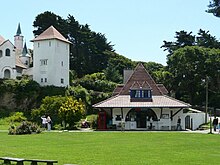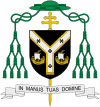Church in Pembrokeshire, Wales
| Caldey Abbey | |
|---|---|
 | |
 | |
| 51°38′14″N 4°41′04″W / 51.637303°N 4.684337°W / 51.637303; -4.684337 | |
| Location | Caldey Island, Pembrokeshire |
| Country | Wales |
| Denomination | Roman Catholic Church |
| Website | www |
| History | |
| Status | Abbey |
| Founded | 1910 |
| Architecture | |
| Functional status | Active |
| Heritage designation | Grade II* listed |
| Administration | |
| Deanery | Pembroke |
Caldey Abbey is an abbey of the Trappists situated on Caldey Island off the coast of Pembrokeshire, Wales, south of Tenby.
Caldey Island thrived as a centre of Cistercian activity in the Middle Ages. The current abbey is modern; it was built in 1910 by Anglican Benedictine monks; they converted to Catholicism and became members of the Trappist Order in 1929. As of 2018, there are about 10 members.
History
A Celtic monastery was founded on the island in the sixth century, and a Benedictine foundation existed from 1136 until the dissolution of the monasteries in 1536. Pyro was the first abbot and Saint Samson was one of the early abbots.
William Done Bushell offered the island to Dom Aelred Carlyle in 1900. An Anglican Benedictine community, led by Carlyle, arrived six years later in 1906, and built the current abbey in the Italian style with assistance from Lord Halifax and others between 1906 and 1910. Initially a row of cottages were built for the people working on the building; hence the abbey was named as "cottage Monastery." The chapel was added in 1910. Three years later the monks were received by the Roman Catholic Church, except for a small Anglican remnant which left Caldey and moved into Abbey House, next to Pershore Abbey, Worcestershire. This was a house which had belonged to Caldey Abbey, but was returned in 1913 to its original, Anglican donor. The Anglican Benedictine community moved on from Pershore to Nashdom Abbey in 1926.
The Catholic Benedictines moved to Prinknash Abbey, Gloucestershire by 1928. Monks from the Trappist Order, who now occupy the abbey, came in 1929 from Scourmont Abbey in Belgium. The monastery was rebuilt in 1940, after a fire.
Monastic life
Perfume, shortbread and chocolate production all provide income for the monks, as well as the sale of prime beef. The monastery opened an internet shop in 2001. Chocolate is also sold under the "Abbot's Kitchen" brand. The monastery used to operate a now-defunct dairy which would sell iced confectionery and cake.
Lavender perfume
Profuse growth of wild lavender flowers on Caldey Island prompted the monks of the abbey to create scents with new fragrances. They branded the scents and marketed them with the brand name “Caldey Abbey Perfumes.” With rising demand for the scent, there was need to import scent oil from outside the island. The scent is now manufactured throughout the year and is partly based on the island's gorse.
Architecture and fittings

Plans began in 1906, when architect J.C. Hawes designed a master plan to evoke the medieval abbeys of Cluny, Vézelay, or Durham. John Coates Carter designed the structure in the Arts and Crafts style. It was his largest project. The roofs are of white roughcast with red tiling, while the large basement arches are of brick. The abbey church has a south tower, with five side-windows, and has a "tapering" tower with primitive crenellations. Originally, the fittings included silver and ebony altar decorations and other luxurious items, but many were destroyed in the 1940 fire. The refectory of the Abbey was made from fine timber. Inspired by an ancient pattern, it was nonetheless modern in design. Two large water tanks underground and a narrow water shaft eliminate the threat of water scarcity in dry seasons.
It is a Grade II* listed building, as is the Abbey Shop, as well as a number of other buildings on the island.
Child abuse lawsuit
See also: Caldey Island § Child sexual abuseIn August 2016, three women launched legal action against the abbey seeking compensation for sexual abuse they had suffered at the hands of one of the abbey's monks between 1972 and 1987, when they were children. They alleged that Father Thaddeus Kotik, who lived in the abbey from 1947 until his death in 1992, abused at least six girls whose families holidayed on the island. The abbey reached a financial settlement with six claimants and apologised for failing to report the abuse when they became aware of it in 1990. Dyfed-Powys Police were made aware in 2014 and 2016. Six victims received financial compensation under an out-of-court settlement reached in March 2017.
In November 2017, as a result of media coverage of the allegations, five more women came forward to accuse Kotik of abusing them. At the same time it emerged that Paul Ashton, a fugitive child sex offender, had fled to the abbey in 2004 and remained there until 2011 using a pseudonym. He was arrested after a visitor recognised him from Crimestoppers' "Most Wanted" list. During his time at the abbey Ashton, who had absconded from West Sussex, operated the island's satellite internet and telephone systems, managed online accommodation bookings and accounts, and worked in the mail room. Ashton pleaded guilty to possessing more than 5,000 indecent images of children, including on computer equipment at the abbey.
In 2021 a man came forward saying that he had also been a victim and demanding a public enquiry into the events and subsequent cover-up. In 2024 the abbey instituted and published an independent review, headed by Jan Pickles, a former assistant police and crime commissioner at South Wales Police.
See also
References
- "Caldey : Order of Cistercians of the Strict Observance: OCSO". Retrieved 24 October 2018.
- "The story behind Caldey Island". BBC News. 21 November 2017. Retrieved 24 October 2018.
- ^ Williams 2001, p. 294.
- "Caldey Island Pembrokeshire Wales". Caldey-island.co.uk. Retrieved 5 May 2013.
- ^ Lloyd, Thomas; Orbach, Julian; Scourfield, Robert (2004). Pembrokeshire: The Buildings of Wales. Yale University Press. pp. 142–. ISBN 978-0-300-10178-2. Retrieved 4 May 2013.
- "Cistercian Order statistics". Retrieved 20 July 2018.
- "The Monks of Caldey Island". Caldey Island. Archived from the original on 27 May 2013. Retrieved 4 May 2013.
- ^ Williams 2001, p. 293.
- ^ Gordon Beattie (1997). Gregory's Angels: A History of the Abbeys, Priories, Parishes and Schools of the Monks and Nuns Following the Rule of Saint Benedict in Great Britain, Ireland and Their Overseas Foundations : to Commemorate the Arrival of Saint Augustine in Kent in 597 AD. Gracewing Publishing. pp. 88–. ISBN 978-0-85244-386-6. Retrieved 5 May 2013.
- Dunstan (2009), p. 22.
- Dunstan (2009), p. 73.
- "Our Monastic Island - a brief history". www.caldeyislandwales.com. Retrieved 25 November 2017.
- ^ "Monks get internet shopping habit". BBC News. 24 October 2001.
- "Chocolate Bars 5 x 69g". Caldey Island Webshop. Retrieved 4 May 2013.
- "Perfume Making on Caldey". Caldey-island.co.uk. Retrieved 5 May 2013.
- Peter Frederick Anson: Building up the waste places: the revival of monastic life on medieval lines in the post-Reformation Church of England, 1973, p. 218.
- ^ Thomas, Phil. "Building a Sense of Place". Building Conservation. Retrieved 5 May 2013.
- Eugène Augustin Roulin (1947). Modern Church Architecture. B. Herder Book Company. Retrieved 5 May 2013.
- Cadw. "Caldey Abbey (Grade II*) (17324)". National Historic Assets of Wales. Retrieved 21 July 2019.
- "Caldey Abbey, Tenby". British Listed Buildings. Retrieved 23 July 2015.
- "British Listed Buildings: Caldey". Retrieved 21 July 2019.
- Gearing, Amanda (17 November 2017). "Revealed: monk who abused children on 'crime free' Caldey Island for decades". The Guardian. Retrieved 18 November 2017.
- "Caldey Abbey apology over handling of monk sex abuse claims". BBC News. 22 November 2017. Retrieved 22 November 2017.
- "Caldey Island monk sexual abuser was warned by abbot". BBC News. 21 November 2017. Retrieved 21 November 2017.
- ^ Loader, Gwyn (10 April 2024). "Caldey Island historical child sex abuse review announced". BBC News. Retrieved 10 April 2024.
- ^ "Caldey Island: Sex offender evaded justice at abbey". BBC News. 25 November 2017.
- Clements, Laura (26 December 2021). "'I was sexually abused by monks living on Caldey Island'". Wales Online. Retrieved 21 June 2022.
- Jan Rossey, Abbot of Caldey (10 December 2024). "Safeguarding". Caldey Island. Retrieved 10 December 2024.
Bibliography
- The Benedictines of Caldey: The Story of the Anglican Benedictines of Caldey and Their Submission to the Catholic Church, with illustrations by the author. London: Burns, Oates & Washbourne. 1940. LCCN 40030835.
- Dunstan, Petà (2009). The Labour of Obedience: The Benedictines of Pershore, Nashdom and Elmore - a History. Norwich: Canterbury Press. ISBN 978-1-85311-974-3.
- Williams, David H. (2001). The Welsh Cistercians: Written to Commemorate the Centenary of the Death of Stephen William Williams (1837-1899), the Father of Cistercian Archaeology in Wales (3 ed.). Gracewing. ISBN 9780852443545.
External links
- "Caldey Monastery, Caldey Island (247)". Coflein. RCAHMW.
| Diocese of Menevia | ||
|---|---|---|
| Roman Catholic Diocese of Menevia | ||
|  | |
| ||
| ||
| ||
| ||
| ||